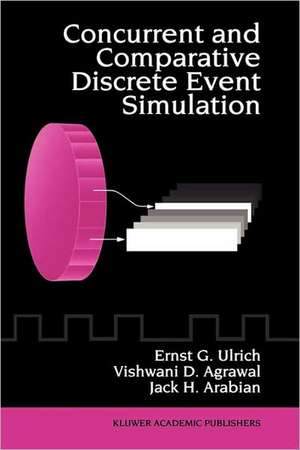Concurrent and Comparative Discrete Event Simulation
Autor Ernst G. Ulrich, Vishwani D. Agrawal, Jack H. Arabianen Limba Engleză Hardback – 31 dec 1993
| Toate formatele și edițiile | Preț | Express |
|---|---|---|
| Paperback (1) | 636.12 lei 43-57 zile | |
| Springer Us – 27 sep 2012 | 636.12 lei 43-57 zile | |
| Hardback (1) | 642.18 lei 43-57 zile | |
| Springer Us – 31 dec 1993 | 642.18 lei 43-57 zile |
Preț: 642.18 lei
Preț vechi: 755.51 lei
-15% Nou
Puncte Express: 963
Preț estimativ în valută:
122.92€ • 133.56$ • 103.32£
122.92€ • 133.56$ • 103.32£
Carte tipărită la comandă
Livrare economică 21 aprilie-05 mai
Preluare comenzi: 021 569.72.76
Specificații
ISBN-13: 9780792394112
ISBN-10: 0792394119
Pagini: 186
Ilustrații: XVII, 186 p.
Dimensiuni: 155 x 235 x 13 mm
Greutate: 0.47 kg
Ediția:1994
Editura: Springer Us
Colecția Springer
Locul publicării:New York, NY, United States
ISBN-10: 0792394119
Pagini: 186
Ilustrații: XVII, 186 p.
Dimensiuni: 155 x 235 x 13 mm
Greutate: 0.47 kg
Ediția:1994
Editura: Springer Us
Colecția Springer
Locul publicării:New York, NY, United States
Public țintă
ResearchCuprins
1 Introduction and Overview.- 1.1 Comparative Experimentation.- 1.2 The Evolution of Concurrent Simulation.- 1.3 Historical Facts, Major Features, and Major Advantages of CCS/MDCCS.- 1.4 Conceptual Overviews of CCS and MDCCS.- 1.5 Multi-List-Traversal.- 1.6 Orthogonal and Non-Orthogonal Domains.- 1.7 Statistical Simulation Control.- 1.8 Observation and the Use of Signatures.- 1.9 Selective-Trace/Event-Driven Simulation.- 1.10 Behavioral Modeling for CCS and MDCCS.- 1.11 Conclusion.- 1.12 References.- 2 New Applications.- 2.1 Introduction.- 2.2 The New Applications.- 2.3 References.- 3 History and Background: Digital Logic and Fault Simulation.- 3.1 Introduction.- 3.2 Logic Simulation in the 1950s and 1960s.- 3.3 Accuracy based on the X-State.- 3.4 Compiled Logic Simulation.- 3.5 Selective-Trace and Event-Driven Logic Simulation (Discrete Event Simulation).- 3.6 Event Scheduling and Execution.- 3.7 Simulation beyond the Gate-Level.- 3.8 Switch-Level Simulation.- 3.9 Min-Max Logic Simulation and Timing Verification.- 3.10 Hardware Simulation Engines.- 3.11 Terminology for Digital Logic Simulation.- 3.12 Modeling and Primitive Models.- 3.13 Table-Lookup.- 3.14 The Simulation of Memories.- 3.15 A Neglected Viewpoint — Instruction-Level Modeling and Simulation.- 3.16 High-Level Logic Simulation; Execution of Computer Programs.- 3.17 A Rehearsal Strategy.- 3.18 Faults for Fault and Design Simulation.- 3.19 Simultaneous Fault Simulation Methods.- 3.20 Miscellaneous Comments and Conclusions.- 3.21 References.- 4 Concurrent Fault Simulation.- 4.1 Introduction.- 4.2 Basic Concurrent Fault Simulation.- 4.3 Co-detection, Signatures, and Rehearsal Simulation.- 4.4 Types of Faults.- 4.5 Conclusion.- 4.6 References.- Chapters 5 Multi-List-Traversal.- 5.1 Introduction.- 5.2 MLTVariations.- 5.3 Axioms, Features, and Implementation Strategies.- 5.4 Specifics of Multi-List-Traversal.- 5.5 An MLT-Variation Based on Selective Traversal.- 5.6 Conclusion.- 5.7 References.- 6 Observation.- 6.1 Introduction.- 6.2 Advantages over Conventional, Serial Observation.- 6.3 Signatures, Distances, Sizes, Profiles, and Event Counts.- 6.4 A Per-Experiment Access Count.- 6.5 Conclusion.- 7 Multi-Domain Concurrent and Comparative Simulation.- 7.1 Introduction.- 7.2 MDCCS Basics.- 7.3 Efficiency Through Similarity.- 7.4 Storage Replication.- 7.5 Observation Precision with MDCCS.- 7.6 Further Efficiency Considerations.- 7.7 Multi-List Traversal.- 7.8 The MDCCS Multi-List Traversal.- 7.9 Conclusion.- 7.10 References.- 8 Fault Simulation of Diagnostic Programs.- 8.1 Introduction.- 8.2 An Overview of the Concurrent Simulation of Diagnostic Programs; Detection and Isolation.- 8.3 Memory Simulation; Accurate X-state Simulation for Memories.- 8.4 Observation and Statistics for Diagnostic Investigation.- 8.5 Conclusion: New Diagnostic Strategies.- 8.6 Reference.- 9 Concurrent Software Simulation (CSS).- 9.1 Introduction.- 9.2 An Example of CSS.- 9.3 CSS as a General Purpose Behavioral Modeling Method.- 9.4 Reference.- 10 Min-Max Simulation.- 10.1 Introduction.- 10.2 Terminology.- 10.3 Philosophies, Strategies, and Miscellaneous Facts.- 10.4 Ambiguity Propagation.- 10.5 The S-algorithm; Detecting False Glitches with the Help of S-Experiments.- 10.6 References.- 11 Concurrent Test Generation.- 11.1 Introduction.- 11.2 Fault Simulator Used as Test Evaluator.- 11.3 Fault Simulator Used as Test Generator.- 11.4 Contest Algorithm.- 11.5 Contest Test Generator.- 11.6 Complexity of Concurrent Test Generation.- 11.7 Conclusion.- 11.8 References.- 12 Simulation on Multiprocessors.- 12.1 Introduction.- 12.2 Parallel Processing.- 12.3 Data Parallel Simulation.- 12.4 CFS on MARS Multiprocessor.- 12.5 Conclusion.- 12.6 References.- 13 Conclusion and Future Work.- 13.1 References.











